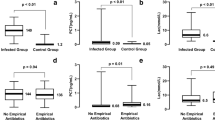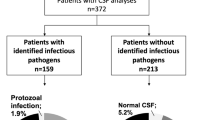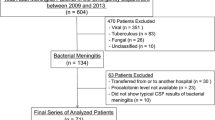Abstract
The aim of the present study was to evaluate the potential role of cerebrospinal fluid soluble urokinase receptor (suPAR) level, infection and age as risk factors for fatal outcome in patients suspected of having meningitis and/or bacteraemia on admission to hospital. A total of 545 cerebrospinal fluid samples from patients with clinically suspected meningitis were sent to the Hellenic National Meningitis Reference Laboratory. Ten of 545 (1.83%) patients died. Analysis by receiver operating characteristics (ROC) curve revealed that both suPAR and age were significant for prediction of fatal outcome. Patients with levels of suPAR above the cut-off values and age ≥51 years, or patients in which either Neisseria meningitis or Streptococcus pneumoniae were detected were categorized as high risk patients. The combination of the above three predictors (suPAR, age and infectious agent) in a logistic regression model with outcome of infection as the dependent variable yielded an overall odds ratio (OR = 85.7, 95% CI 10.6–690.2) with both sensitivity and specificity being equal to the value of 0.9. In conclusion, suPAR, age and type of infection have an additive effect in predicting mortality among patients suspected of meningitis.


Similar content being viewed by others
References
Bass R, Ellis V (2009) Regulation of urokinase receptor function and pericellular proteolysis by the integrin alpha(5) beta(1). Thromb Haemost 101:954–962
Cinque P, Nebuloni M, Santovito ML, Price RW, Gisslen M, Hagberg L, Bestetti A, Vago G, Lazzarin A, Blasi F, Sidenius N (2004) The urokinase receptor is overexpressed in the AIDS dementia complex and other neurological manifestations. Ann Neurol 55:687–694
de Jonge RC, van Furth AM, Wassenaar M, Gemke RJ, Terwee CB (2010) Predicting sequelae and death after bacterial meningitis in childhood: a systematic review of prognostic studies. BMC Infect Dis 10:232–235
Djoba Siawaya JF, Bapela NB, Ronacher K, Veenstra H, Kidd M, Gie R, Beyers N, van Helden P, Walzl G (2008) Immune parameters as markers of tuberculosis extent of disease and early prediction of anti-tuberculosis chemotherapy response. J Infect 56:340–347
Eugen-Olsen J, Andersen O, Linneberg A, Ladelund S, Hansen TW, Langkilde A, Petersen J, Pielak T, Møller LN, Jeppesen J, Lyngbaek S, Fenger M, Olsen MH, Hildebrandt PR, Borch-Johnsen K, Jørgensen T, Haugaard SB (2010) Circulating soluble urokinase plasminogen activator receptor predicts cancer, cardiovascular disease, diabetes and mortality in the general population. J Intern Med 268:296–308
Garcia-Monco JC, Coleman JL, Benach JL (2002) Soluble urokinase receptor (uPAR, CD 87) is present in serum and cerebrospinal fluid in patients with neurologic diseases. J Neuroimmunol 129:216–223
Hansen NE, Karle H, Jensen A, Bock E (1977) Lysozyme activity in cerebrospinal fluid. Studies in inflammatory and non-inflammatory CNS disorders. Acta Neurol Scand 55:418–424
Henic E, Borgfeldt C, Christensen IJ, Casslén B, Høyer-Hansen G (2008) Cleaved forms of the urokinase plasminogen activator receptor in plasma have diagnostic potential and predict postoperative survival in patients with ovarian cancer. Clin Cancer Res 14:5785–5793
Koedel U, Klein M, Pfister HW (2010) New understandings on the pathophysiology of bacterial meningitis. Curr Opin Infect Dis 23(3):217–223
Lawn SD, Myer L, Bangani N, Vogt M, Wood R (2007) Plasma levels of soluble urokinase-type plasminogen activator receptor (suPAR) and early mortality risk among patients enrolling for antiretroviral treatment in South Africa. BMC Infect Dis 17:7–41
Lomholt AF, Christensen IJ, Høyer-Hansen G, Nielsen HJ (2010) Prognostic value of intact and cleaved forms of the urokinase plasminogen activator receptor in a retrospective study of 518 colorectal cancer patients. Acta Oncol 49(6):805–811
Ostergaard C, Benfield T, Lundgren JD, Eugen-Olsen J (2004) Soluble urokinase receptor is elevated in cerebrospinal fluid from patients with purulent meningitis and is associated with fatal outcome. Scand J Infect Dis 36:14–19
Ostrowski SR, Ullum H, Goka BQ, Høyer-Hansen G, Obeng-Adjei G, Pedersen BK, Akanmori BD, Kurtzhals JA (2005) Plasma concentrations of soluble urokinase-type plasminogen activator receptor are increased in patients with malaria and are associated with a poor clinical or a fatal outcome. J Infect Dis 191:1331–1341
Paul R, Winkler F, Bayerlein I, Popp B, Pfister HW, Koedel U (2005) Urokinase-type plasminogen activator receptor regulates leukocyte recruitment during experimental pneumococcal meningitis. J Infect Dis 191(5):776–782
Rabna P, Andersen A, Wejse C, Oliveira I, Gomes VF, Haaland MB, Aaby P, Eugen-Olsen J (2009) High mortality risk among individuals assumed to be TB-negative can be predicted using a simple test. Trop Med Int Health 14:986–994
Ragno P (2006) The urokinase receptor: a ligand or a receptor? Story of a sociable molecule. Cell Mol Life Sci 63:1028–1037
Rigolin GM, Tieghi A, Ciccone M, Bragotti LZ, Cavazzini F, Della Porta M, Castagnari B, Carroccia R, Guerra G, Cuneo A, Castoldi G (2003) Soluble urokinase-type plasminogen activator receptor (suPAR) as an independent factor predicting worse prognosis and extra-bone marrow involvement in multiple myeloma patients. Br J Haematol 120:953–959
Sidenius N, Sier CF, Ullum H, Pedersen BK, Lepri AC, Blasi F, Eugen-Olsen J (2000) Serum level of soluble urokinase-type plasminogen activator receptor is a strong and independent predictor of survival in human immunodeficiency virus infection. Blood 96:4091–4095
Tang YL, Zhu GQ, Hu L, Zheng M, Zhang JY, Shi ZD, Liang XH (2010) Effects of intra-articular administration of sodium hyaluronate on plasminogen activator system in temporomandibular joints with osteoarthritis. Oral Surg Oral Med Oral Pathol Oral Radiol Endod 109(4):541–547
Tarui T, Mazar AP, Cines DB, Takada Y (2001) Urokinase-type plasminogen activator receptor (CD87) is a ligand for integrins and mediates cell-cell interaction. J Biol Chem 276:3983–3990
Theodoridou MN, Vasilopoulou VA, Atsali EE, Pangalis AM, Mostrou GJ, Syriopoulou VP, Hadjichristodoulou CS (2007) Meningitis registry of hospitalized cases in children: epidemiological patterns of acute bacterial meningitis throughout a 32-year period. BMC Infect Dis 7:101
Tzanakaki G, Tsopanomichalou M, Kesanopoulos K, Matzourani R, Sioumala M, Tabaki A, Kremastinou J (2005) Simultaneous single-tube PCR assay for the detection of Neisseria meningitidis, Haemophilus influenzae type b and Streptococcus pneumoniae. Clin Microbiol Infect 11:386–390
Vergouwen MD, Schut ES, Troost D, van de Beek D (2010) Diffuse cerebral intravascular coagulation and cerebral infarction in pneumococcal meningitis. Neurocrit Care 13(2):217–227
Wang W, Wang HY, Cui ZG, Wang J (2008) Plasma suPAR level in patients with multiple myeloma. Zhongguo Shi Yan Xue Ye Xue Za Zhi 16:197–199
Wittenhagen P, Kronborg G, Weis N, Nielsen H, Obel N, Pedersen SS, Eugen-Olsen J (2004) The plasma level of soluble urokinase receptor is elevated in patients with Streptococcus pneumoniae bacteraemia and predicts mortality. Clin Microbiol Infect 10:409–415
Xirogianni A, Tzanakaki G, Karagianni E, Markoulatos P, Kourea-Kremastinou J (2009) Development of a single-tube PCR assay for the simultaneous detection of Haemophilus influenzae, Pseudomonas aeruginosa, Staphylococcus aureus and Streptococcus spp. directly in clinical samples. Diagn Microbiol Infec Dis 63:121–126
Acknowledgements
We are grateful to Prof Caroline C Blackwell for editing this manuscript. This study was supported by grants from the “Alexander S. Onassis” Public Benefit Foundation, Athens, Greece, and the suPARnostic ELISA assays were kindly provided by ViroGates, Denmark.
Author information
Authors and Affiliations
Corresponding author
Rights and permissions
About this article
Cite this article
Tzanakaki, G., Paparoupa, M., Kyprianou, M. et al. Elevated soluble urokinase receptor values in CSF, age and bacterial meningitis infection are independent and additive risk factors of fatal outcome. Eur J Clin Microbiol Infect Dis 31, 1157–1162 (2012). https://doi.org/10.1007/s10096-011-1423-7
Received:
Accepted:
Published:
Issue Date:
DOI: https://doi.org/10.1007/s10096-011-1423-7




